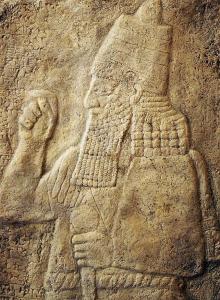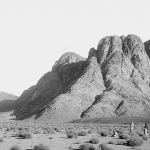Bryan Windle states,
Sennacherib is mentioned by name 16 times in Scripture, more than any other Assyrian ruler. From a biblical perspective, he is most famous for his invasion of Judah in 701 BC and his siege against King Hezekiah and Jerusalem (2 Ki 18-19; 2 Ch 32; Is 37). (1)
He reigned as king from 705/704 to 681 B.C. (2). As to the dates of reign of King Hezekiah of Judah, Encyclopedia Britannica observes, “The dates of his reign are often given as about 715 to about 686 BC, . . .” (3). Archaeologist and Egyptologist Kenneth A. Kitchen concurs with Hezekiah’s dates. (4) 2 Kings 18:2 (RSV) informs us that “he reigned twenty-nine years in Jerusalem.” Thus, we have a strong correspondence in the time of reigns between the two kings, which already backs up the biblical account.
2 Kings 18:13-15, 17 In the fourteenth year of King Hezekiah Sennacherib king of Assyria came up against all the fortified cities of Judah and took them. And Hezekiah king of Judah sent to the king of Assyria at Lachish, saying, “I have done wrong; withdraw from me; whatever you impose on me I will bear.” And the king of Assyria required of Hezekiah king of Judah three hundred talents of silver and thirty talents of gold. And Hezekiah gave him all the silver that was found in the house of the LORD, and in the treasuries of the king’s house. . . . And the king of Assyria sent the Tartan, the Rabsaris, and the Rabshakeh with a great army from Lachish to King Hezekiah at Jerusalem. And they went up and came to Jerusalem. When they arrived, they came and stood by the conduit of the upper pool, which is on the highway to the Fuller’s Field.
Scripture also states that Sennacherib failed to conquer Jerusalem (2 Kings 18:28-35) during his military exploits of 701 B.C. Sennacherib in his annals provides information that corroborates the biblical account,
As for Hezekiah, the Jew, who did not submit to my yoke, 46 of his strong cities, as well as the small cities in their neighborhood, which were without number – by levelling with battering-rams (?) and by bringing up siege-engines (?), I besieged and took (those cities). . . . Himself, like a caged bird I shut up in Jerusalem his royal city….In addition to the 30 talents of gold and 800 talents of silver (there were), gems, cosmetics (?), jewels (?), large sandu-stones, couches of ivory, house chairs of ivory, elephant hide, ivory (lit. elephant’s teeth), ushu-wood, ukarinnu-wood, all kinds of valuable (heavy) treasures, . . . (5)
The similarities of the accounts of taking the fortified cities is striking, as is the exact amount of gold given by Hezekiah to Sennacherib as tribute. The much larger amount of silver in the Assyrian chronicle might very well be paralleled in the biblical description: “Hezekiah gave him all the silver that was found in the house of the LORD, and in the treasuries of the king’s house.” Ultimately, Sennacherib doesn’t record that he took Jerusalem, and this lines up with the Bible and a prophecy from the prophet Isaiah (2 Kings 19:20) to Hezekiah,
2 Kings 19:32-34 “Therefore thus says the LORD concerning the king of Assyria, He shall not come into this city or shoot an arrow there, or come before it with a shield or cast up a siege mound against it. By the way that he came, by the same he shall return, and he shall not come into this city, says the LORD. For I will defend this city to save it, for my own sake and for the sake of my servant David.”
Sennacherib’s death is also similarly detailed in biblical and Assyrian records,
2 Kings 19:37 And as he was worshiping in the house of Nisroch his god, Adrammelech and Sharezer, his sons, slew him with the sword, and escaped into the land of Ararat. And Esarhaddon his son reigned in his stead. (cf. Isa. 37:38)
Esarhaddon refers to his father’s murder, committed by his brothers:
My brothers went mad and whatever was wicked against gods and men they did, and plotted evil: they drew the sword in the midst of Nineveh godlessly: to exercise the kingship against each other they rushed like young steers. (6) . . . those rebels, the ones engaged in revolt and rebellion, when they heard of the advance of my campaign, they deserted the army they relied on and fled to an unknown land. (7)
Kitchen adds fascinating details,
The biblical Adrammelek is a form of Arda-mulissi (the name of Sennacherib’s murderous eldest son in contemporary documents) . . . (8)
Sennacherib in his annals gets theological: “In my 7th campaign, (the god) Ashur my Lord supported me . . . against Elam . . .” . . . The ancient writer’s theological beliefs ibn each case have nothing to do with the reality of the events — only with the imputed cause behind the events. So we can no more dismiss 2 Kings 18-19 (even if we believe in neither YHWH nor his angel of death) than the annals of Sennacherib (even though nobody today believes in Ashur!), backed up as they are by the nontheological precis in the Babylonian Chronicle.
In short, the Hebrew narratives in Kings and Chronicles should be treated as impartially and fairly as most properly knowledgeable Assyriologists, Hittitologists, and Egyptologists normally treat the firsthand and fully comparable ancient documents in their domain. Hypercriticism of the Hebrew data is wrong in attitude, methods, and results alike. (9)
Additionally, Assyrian records note Sennacherib’s siege of Lachish,
The siege and capture of Lachish . . . is the centerpiece to a splendid set of scenes showing the Assyrian forces attacking, then actively pressing their siege to break into Lachish, capture the town, and lead out captives. . . . The mound of Tell ed-Duweir . . . revealed the battered bulk of the Assyrian siege ramp (as shown on the reliefs) up to the walls, plus a Hebrew counterramp within the walls. The city, destroyed by the Assyrians, is Lachish level III archaeologically. (10)
This lines up (as always!) with the biblical mention of the same siege:
2 Chronicles 32:9 . . . Sennach’erib king of Assyria, who was besieging Lachish with all his forces, . . .
2 Kings 19:32 (see above) indirectly refers to this siege ramp, in stating that Sennacherib would not (and in fact he did not) “cast up a siege mound against” Jerusalem, as he presumably did against other cities (Lachish being one).
Some, however, think that this siege was carried out by the Babylonian king Nebuchadnezzar, some 114 years later. Not so, according to an article in the Oxford Journal of Archaeology, in an article dated October 14, 2021. (11) This significant research article was reported on by The Times of Israel (12), The Jerusalem Post (13), and Haaretz (14).
FOOTNOTES
1) Bryan Windle, “Sennacherib: An Archaeological Biography,” Bible Archaeology Report, July 3, 2020. https://biblearchaeologyreport.com/2020/07/03/sennacherib-an-archaeological-biography/.
2) Henry W. F. Saggs, “Sennacherib,” in Encyclopedia Britannica. https://www.britannica.com/biography/Sennacherib.
3) “Hezekiah,” in Encyclopedia Britannica. https://www.britannica.com/biography/Hezekiah.
4) Kenneth A, Kitchen, On the Reliability of the Old Testament (Grand Rapids, Michigan: Wm. B. Eerdmans Publishing Co., 2003), 31.
5) Daniel David Luckenbill, The Annals of Sennacherib (Chicago: The University of Chicago Press, 1924), 11-12. https://oi.uchicago.edu/sites/oi.uchicago.edu/files/uploads/shared/docs/oip2.pdf.
6) “The Esarhaddon Prism,” The British Museum. https://www.britishmuseum.org/collection/object/W_1929-1012-1.
7) “Ninevah A,” The Royal Inscriptions of the Neo-Assyrian Period. http://oracc.museum.upenn.edu/rinap/corpus/.
8) Kitchen, 42.
9) Kitchen, 51.
10) Kitchen, 42.
11) Yosef Garfinkel, Jon W. Carroll, Michael Pytlik, Madeleine Mumcuoglu, “Constructing the Assyrian Siege Ramp at Lachish: Texts, Iconography, Archaeology and Photogrammetry,” Oxford Journal of Archaeology Volume 40, Issue 4 (November 2021), 417-439. https://onlinelibrary.wiley.com/doi/abs/10.1111/ojoa.12231.
12) Michael Bachner, “How Lachish fell: Study reconstructs Assyrian onslaught almost 3,000 years ago,” The Times of Israel, November 9, 2021. https://www.timesofisrael.com/how-lachish-fell-study-reconstructs-assyrian-onslaught-almost-3000-years-ago/.
13) Rossella Tercatin, “Biblical warfare: How did the Assyrians conquer Judean Lachish?,” The Jerusalem Post, November 9, 2021. https://www.jpost.com/archaeology/biblical-warfare-how-did-the-assyrians-conquer-judean-lachish-684440.
14) Ariel David, “Archaeologists Reveal Secrets of Assyrian War Machine That Conquered Ancient Judah,” Haaretz, November 9, 2021. https://www.haaretz.com/israel-news/2021-11-09/ty-article/archaeologists-reveal-secrets-of-assyrian-war-machine-that-conquered-ancient-judah/0000017f-f57a-d318-afff-f77b80330000.
Related Reading
King Hezekiah: Exciting New Archaeological Findings [12-13-22]
***
Practical Matters: Perhaps some of my 4,200+ free online articles (the most comprehensive “one-stop” Catholic apologetics site) or fifty-one books have helped you (by God’s grace) to decide to become Catholic or to return to the Church, or better understand some doctrines and why we believe them.
Or you may believe my work is worthy to support for the purpose of apologetics and evangelism in general. If so, please seriously consider a much-needed financial contribution. I’m always in need of more funds: especially monthly support. “The laborer is worthy of his wages” (1 Tim 5:18, NKJV). 1 December 2021 was my 20th anniversary as a full-time Catholic apologist, and February 2022 marked the 25th anniversary of my blog.
PayPal donations are the easiest: just send to my email address: [email protected]. You’ll see the term “Catholic Used Book Service”, which is my old side-business. To learn about the different methods of contributing, including 100% tax deduction, etc., see my page: About Catholic Apologist Dave Armstrong / Donation Information. Thanks a million from the bottom of my heart!
***
Photo credit: Timo Roller (5-5-15), Cast of a rock relief of Sennacherib from the foot of Cudi Dağı, near Cizre. The cast is exhibited in Landshut, Germany. [Wikimedia Commons / Creative Commons Attribution 3.0 Unported license]
***
Summary: Overview of the convergence of biblical & archaeological data regarding Assyrian King Sennacherib (r. c. 705-681 B.C.), during the time of King Hezekiah of Judah.













